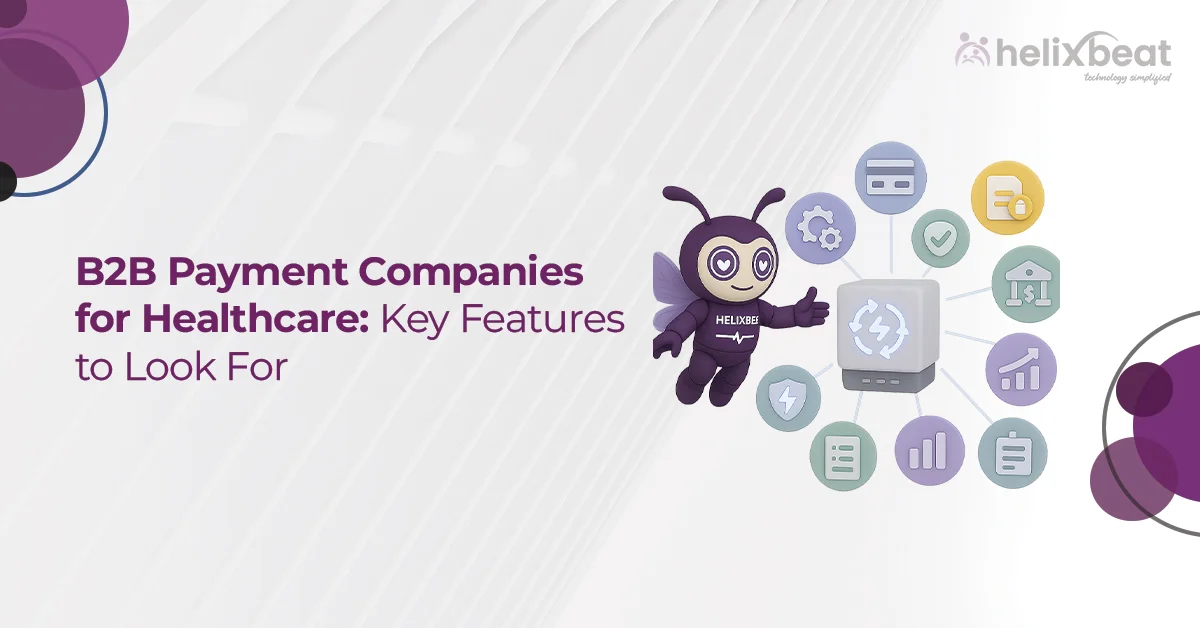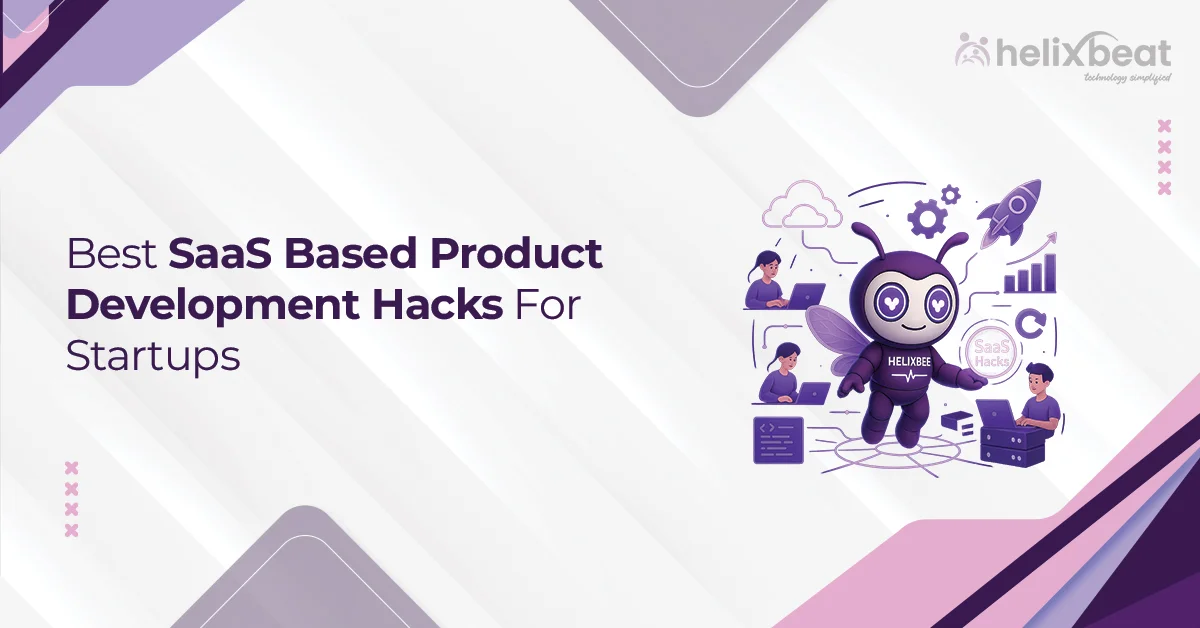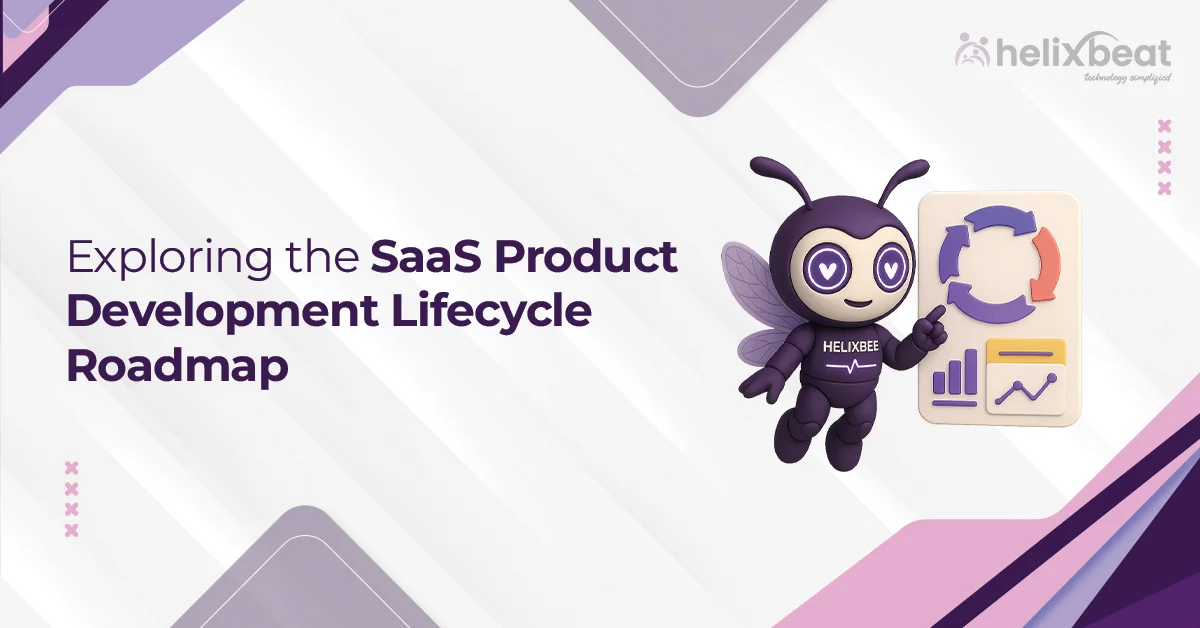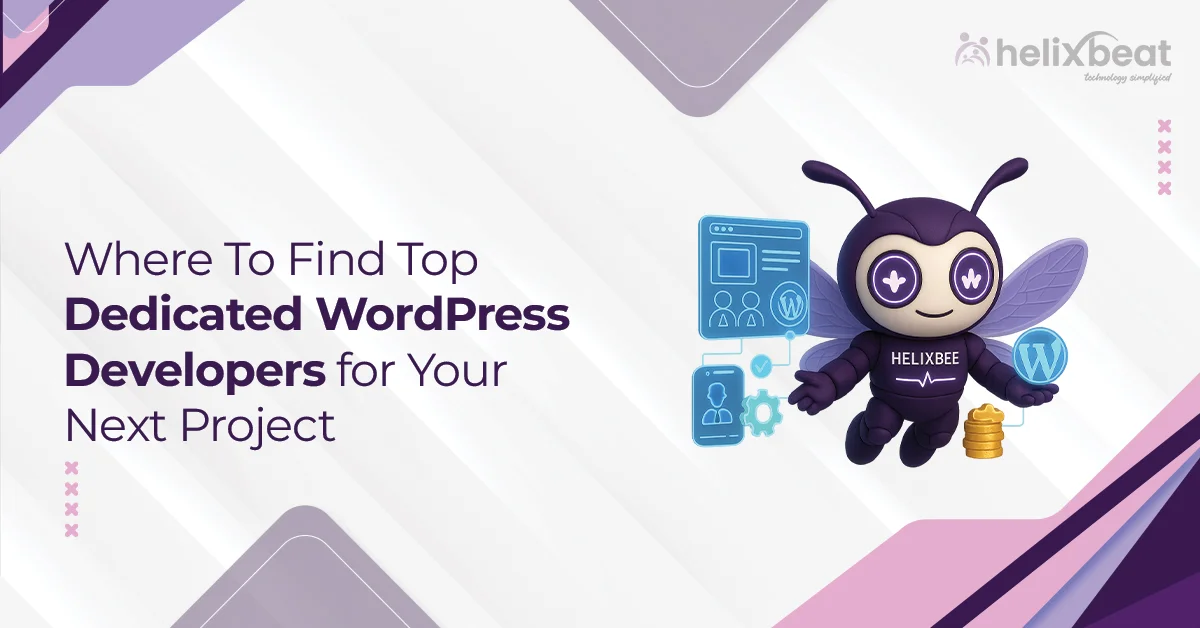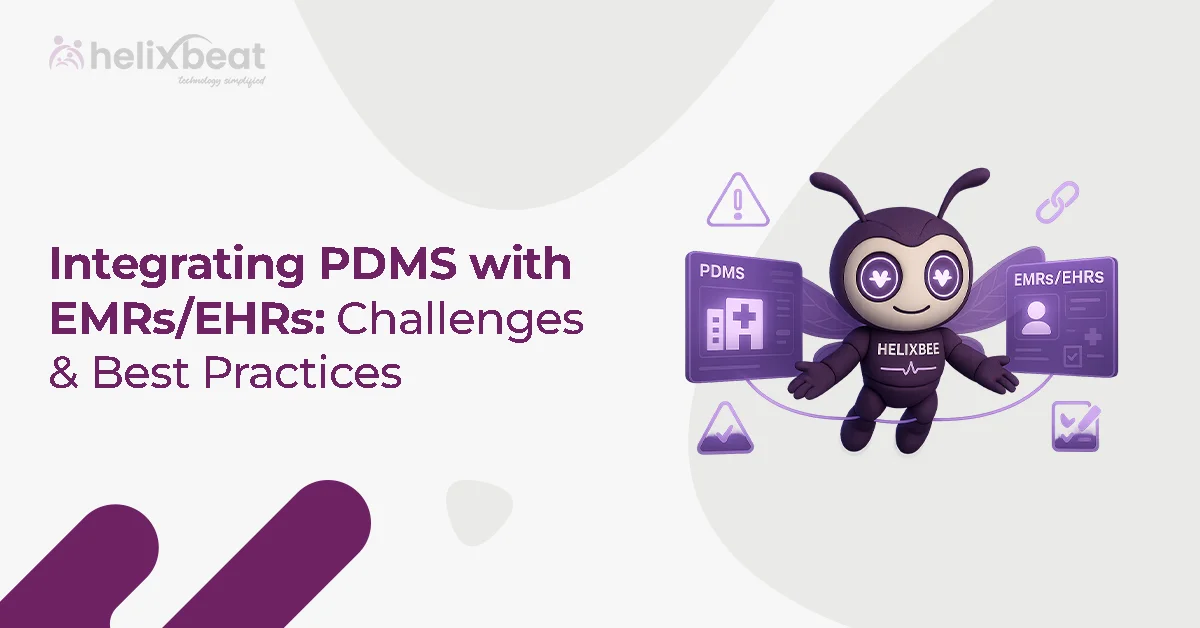As an entrepreneur, you know that 70% of IoT projects fail before they even hit the market. The reasons are often missed in the rush to innovate. Issues like poor scalability, weak security, and integration problems can stop your IoT product in its tracks.
IoT development requires a deep understanding of both hardware and software. If even one element is missed, the product can fail to deliver the value you promised. That’s where IoT software development services play a major role. These experts understand the unique challenges of building IoT products and can help you avoid common pitfalls.
In this blog, we’ll explain the key mistakes you should avoid before IoT software development and best practices to build a successful IoT Product.
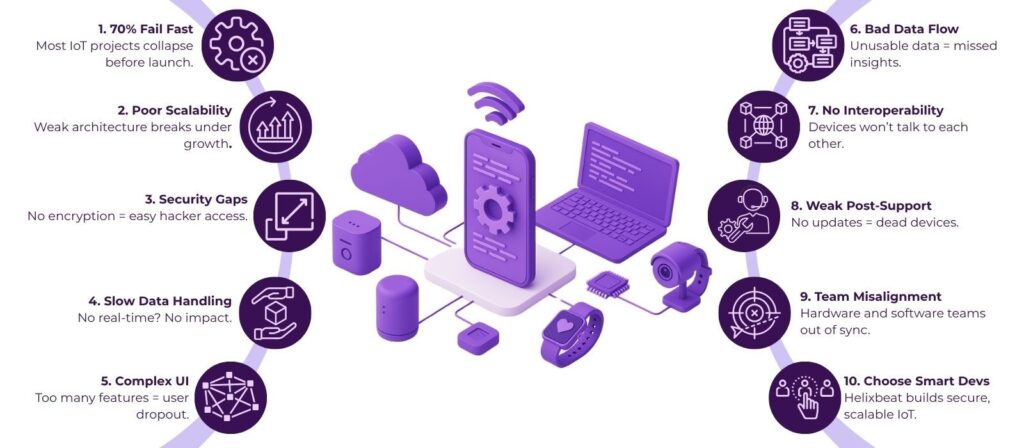
Table of Contents
What is an IoT app, and how does it work?
An IoT app is a software tool that lets users control and monitor smart devices through the internet. These devices could be anything from a fitness tracker to a smart thermostat or factory sensor. The app acts as a bridge between the user and the device, allowing you to send commands, view real-time data, and receive alerts right from your phone or computer.
Here’s how it works: the smart device collects data using sensors and sends it to the cloud through Wi-Fi or Bluetooth. The IoT software development connects to this cloud system, processes the data, and shows it to the user in a simple format. It also allows users to send instructions back to the device, like turning off a light or adjusting machine settings. This two-way connection makes the entire system interactive and intelligent.
Top 5 Mistakes You Must Avoid Before Starting IoT Software Development
Starting an IoT software development project requires careful planning and attention to key factors that can make or break your success. Avoiding these common mistakes will help ensure your IoT solution is scalable, secure, and user-friendly as it grows.
1. Ignoring Scalability and Flexibility in Architecture:
- According to a report by Gartner, 75% of IoT projects fail due to poor scalability planning. Many developers overlook how their systems will handle increasing device numbers, data volumes, and users as the project grows.
- This mistake can lead to significant performance issues and costly redesigns.
2. Overlooking Security at Every Layer:
- McKinsey estimates that 60% of IoT security vulnerabilities are caused by poor security practices during development. IoT devices often lack robust encryption and authentication, exposing systems to cyber threats.
- An insecure device can provide hackers with access to critical data or control over the device itself.
3. Lack of Integration Between Hardware and Software Teams:
- A Forrester survey revealed that 40% of IoT project failures are attributed to misalignment between hardware and software teams.
- When these teams don’t sync their development cycles, issues arise, such as mismatched data formats, failed communications between systems, and device malfunctions, leading to delays and added costs.
4. Not Accounting for Real-Time Data Processing Needs:
- IDC reports that 30% of IoT applications struggle to process real-time data due to inadequate backend infrastructure.
- Without real-time data processing, IoT devices can’t deliver the instant insights or actions required by time-sensitive systems, making the product less effective for critical operations like healthcare or manufacturing.
5. Overcomplicating User Interfaces:
- UserTesting found that 70% of users abandon apps with complicated interfaces. IoT developers often add too many features or overly complex designs, which overwhelm users.
- A convoluted UI leads to poor user adoption and makes the product difficult to use, defeating the purpose of automation and smart tech.
Understand the Reasons Behind IoT Product Failure
Despite the potential of IoT, many products fail due to critical yet avoidable mistakes:
1. Misalignment Between Business Goals and Technical Feasibility
Often, IoT projects are launched without a clear understanding of technical limitations or market needs. This disconnect can lead to systems that work in theory but fail to scale or perform in the real world.
2. Poor Data Management and Architecture
IoT products generate massive data, but without proper architecture to handle it, the data becomes unusable. Inefficient data flow and poor processing can result in slow performance or missed opportunities for actionable insights.
3. Lack of Interoperability
IoT systems rely on multiple devices with different protocols. Without robust interoperability, devices can fail to communicate effectively, leading to integration issues and a fragmented user experience.
4. Inadequate Security Measures
Many IoT products are launched with weak security protocols, making them vulnerable to cyber threats. Insecure devices can lead to data breaches or device manipulation, damaging brand reputation and user trust.
5. Overcomplicating User Experience
Over-engineering the UI with unnecessary features often overwhelms users. A complicated user interface can drive customers away, as simplicity and ease of use are critical for user adoption.
6. Neglecting Post-Deployment Support
Without continuous maintenance, IoT devices quickly deteriorate. Regular updates and monitoring are crucial to ensuring long-term functionality and security, as failure risks the product.
Best Practices for Successful IoT Software Development
In IoT software development, building your project with a strong focus on scalability, security, and flexibility is essential for long-term success. By following these best practices, you can ensure your IoT solution remains adaptable as it grows.
1. Build a Scalable and Flexible Architecture
Design IoT systems with scalability in mind using microservices architecture and cloud-native solutions. This allows systems to handle increasing device volumes and data loads over time without compromising performance.
2. Integrate Security from the Start
Implement end-to-end security by using data encryption, device authentication, and secure communication protocols to protect against cyber threats and ensure compliance with data privacy regulations.
3. Leverage Edge Computing for Real-Time Processing
Use edge computing to process data closer to the source, reducing latency and improving response times for time-sensitive applications like autonomous systems or real-time analytics.
4. Ensure Interoperability Across Systems
Adopt open standards, such as RESTful APIs and OAuth, to enable seamless communication between diverse devices and platforms, ensuring long-term flexibility and integration with existing infrastructure.
5. Focus on Data Management and Analytics
Implement robust data pipelines and integrate machine learning models for real-time data analysis. This enables actionable insights and proactive decision-making, enhancing the value of your IoT solution.
What to Look for in an IoT Development Partner
When choosing a partner for your IoT software development, it’s important to find a team with the right expertise and capabilities. Here’s what you should look for:
Does the Partner Have Real IoT Expertise?
Your partner should have experience in IoT software and hardware development, including edge computing, cloud platforms, and real-time data processing to build scalable and secure solutions.
Are They Serious About Security?
Ensure they prioritize end-to-end encryption, secure authentication, and regular updates to protect your devices and data from security threats.
Can They Scale with Your Growth?
The partner must design solutions that can easily scale to handle an increasing number of devices and data as your IoT system expands, utilizing cloud-native architectures and microservices.
Will It Work Well with Other Systems?
They should be skilled in integrating devices and platforms that utilize open standards, such as APIs, to ensure seamless communication and future flexibility.
Do They Offer Ongoing Support?
Look for a partner that offers ongoing support, including remote monitoring, over-the-air (OTA) updates, and continuous maintenance, to keep your system secure and up-to-date.
Final Words
Launching a successful IoT product goes beyond innovation—it requires smart planning and flawless execution. Many projects fail due to lack of fundamentals like architecture design, security, and system compatibility. By addressing these core elements early, you can avoid critical pitfalls and position your product for long-term success.
That’s where Helixbeat comes in. Our IoT development services are designed to eliminate the guesswork from your product journey. From day one, we focus on building secure, scalable, and future-ready solutions that fit your business goals. With a team that understands both the tech and the market, Helixbeat helps you move faster and avoid costly mistakes.
Are you seeking affordable IoT development services? Schedule your consultation now.
FAQ:
1. What is IoT hardware development?
IoT hardware development involves creating physical devices like sensors, microcontrollers, and connectivity modules that collect and transmit data for IoT systems. These devices are essential for gathering real-time information and interacting with the environment.
2. What software design is used in IoT?
IoT uses embedded software design for programming devices, cloud computing for data storage and analysis, and edge computing for real-time processing. Mobile and web apps are also used to control and monitor IoT devices remotely.
3. How to create IoT software?
To create IoT software, define the use case, select hardware, develop embedded software, set up communication protocols, build cloud infrastructure for data processing, and create user interfaces. Test and deploy for optimal performance.
4. What are the basics of IoT?
The basics of IoT include devices/sensors to collect data, connectivity for data transmission, and software for data processing and analysis, enabling devices to interact and automate tasks.
5. What is IoT with an example?
IoT is a network of connected devices that collect and share data. Example: A smart thermostat that adjusts home temperature based on data it collects and allows remote control via a smartphone app.



